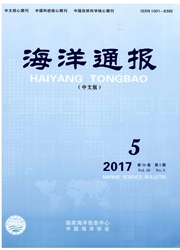

 中文摘要:
中文摘要:
根据2008年8月18日至9月19日在吕宋海峡3个断面获得的O~200i32层浮游植物数据,探讨了群落结构及其与不同理化性质水团的关系。本研究共鉴定浮游植物4门61属169种(包括变种、变型和未定种),其中甲藻和硅藻物种数基本相当,各占所有物种数的50%左右;另记录了金藻门3属3种;蓝藻门1种。海区优势种为卡氏前沟藻Amphisdiniumcarterae、锥状施克里普藻Scripp—siellatrochiodea、角毛藻Chaetocerossp.和原甲藻Prorocenwumsp丰度范围是(0.08~9.48)×10。个/m2,平均为1.448×10个/m2。甲藻占总细胞丰度的74.68%;硅藻占24.96%。在水平方向,B断面和C5站浮游植物丰度较高,甲藻主要分布于远离陆地的海峡中部,而硅藻主要分布于台湾岛和吕宋岛附近;浮游植物垂直分布主要在水体的0~50m层。聚类分析并结合水文数据表明浮游植物基本可划分为3个类群,分别受南海水、黑潮水和混合水的影响。南海水与黑潮水交汇的锋面区域,具有较周围区域更高的物种数、水柱平均丰度及硅甲藻丰度比,体现出强烈的锋面效应。
 英文摘要:
英文摘要:
Phytoplankton were sampled in the up 200 m in the Luzon Strait from 18th August to 19th September, 2008,A total of 169 species belonging to 61 genera of 4 classes were identified. The species richness of dinoflagel-lates and diatoms were both closed to 50% of the total; 3 species belonging to 3 genera of Chrysophyta and 1 spe-cies of Cyanophyta were also identified. The dominant species were Arnpkisdiniurn carlerae, Scrippsiella tro- chiodea, Chaetoceros sp. and Prorocentrurn sp.. The phytoplankton abundances ranged from 0.08 X 106 to 9.48 X 106cells/ma , with average value of 1. 448 X 10 cells/m3. Dinoflagellates contributed to 74. 68% of the total phyto- plankton abundance and diatoms' contribution was 24. 96 %. The horizontal distribution showed that phytoplank ton in section B and station C5 were with relatively high abundances, phytoplankton were dominated by dinoflagel lares which were mainly in the middle of the strait, while diatoms were mainly in the vicinity of the Taiwan Island or the Luzon Island; The horizontal distribution demonstrated that phytoplankton dramatically decreased below 50m. Combined with the hydrologic data,Phytoplankton were clustered into 3 types of community,which was in-fluenced by the South China Sea water, the Kuroshio water and mixed water respectively. There were higher spe-cies richness,water column--integrated abundances and diatoms/dinoflagellates abundance ratio at the frontal zone of the South China Sea and the Kuroshio than those at the adjacent zones,implying significant frontal effect on phy- toplankton community structure.
 同期刊论文项目
同期刊论文项目
 同项目期刊论文
同项目期刊论文
 期刊信息
期刊信息
